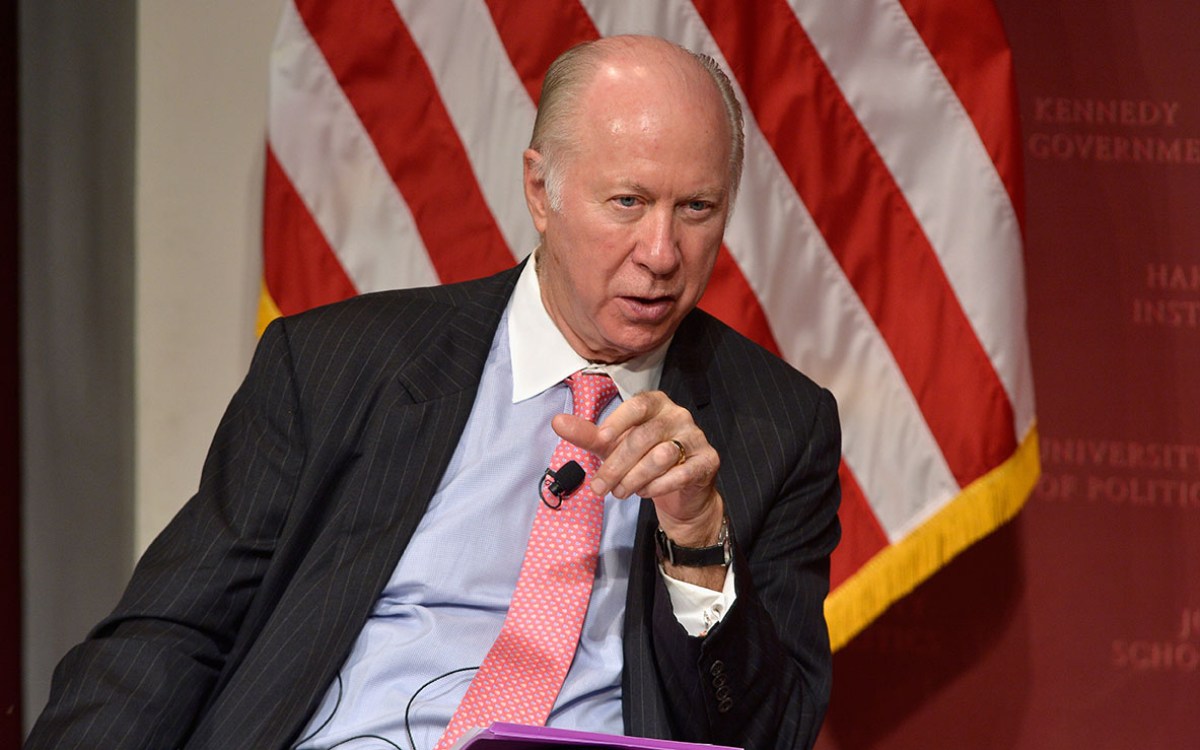Military model may help close gap
Achievement Gap Initiative series ends with a salute
Does the military have anything to teach educators?
Absolutely, said Brookings Institution senior fellow Hugh Price, who, 18 months out of Yale Law School in 1968, gave up his career to become a youth counselor.
At the Harvard Graduate School of Education this week (April 17), he outlined how the military’s rigor, reward systems, and facility for fast learning could be translated into school programs that “reach and respect” troubled adolescents.
Price’s lecture, “Demilitarizing What the Pentagon Knows About Developing Young People,” was the last in the 2006-07 Askwith Education Forum series exploring answers to the achievement gap that divides students along racial and class lines. The series was co-sponsored by Harvard’s Achievement Gap Initiative.
Black and Hispanic secondary school students, on average, read at a level with the lowest quartile of white students. They are less likely to graduate, go on to college, or earn a middle-class living.
Growing up in Eisenhower-era Washington, D.C., Price noticed that school dropouts who joined the military came home “ramrod straight and full of purpose. I knew something powerful had happened.”
In 1975, he tried to drum up support for creating a domestic educational equivalent to the Army experience, but, in the wake of the Vietnam War, ran into distrust of the military.
In the 1980s, Price — by then a vice president at the Rockefeller Foundation — tried the idea out again, and convinced the National Guard to start ChalleNGe, a 22-week intensive program for boys and girls ages 16 to 18. It encourages taking the G.E.D. and instills a change in lifestyle. Afterward, he said, 75 percent of ChalleNGe participants earn a high school equivalency degree, and 51 percent enter the workforce. (Data on the idea of a military model for adolescent education are still sketchy.)
Once Price joined Brookings, where education policy is a research topic, he decided to study the question more deeply, looking for what he called “indicators of promise.”
Price looked at a target population: young people who were performing below grade level in high school, were disengaged from school, or had already dropped out.
It’s a group that put Price squarely into the landscape of the achievement gap, where by fourth grade 58 percent of black students read below a basic level of competency.
It’s also a landscape in which only 20 percent of blacks and 16 percent of Latinos emerge from high school prepared for college — and in which half of all dropouts come from just a few (15 percent) U.S. schools.
In the face of these grim realities, a military-like education model has something to offer, said Price: discipline, accountability, structure, immediate consequences for bad behavior, and the military’s generations of experience in fast-track learning.
Students in the five-month ChalleNGe program, for one, come out with reading improvements of 1.5 grade levels, and two grade levels in math. It also stresses military-style core values, including leadership, citizenship, life coping skills, physical fitness, hygiene, and job skills.
There are already a few military-model public schools — in Pennsylvania, Illinois, Maryland, and California — and all of them have waiting lists. School hours are longer, and the school year is as much as 40 days a year longer.
On the downside, the military model prompts some concerns, said Price, including worry about military content in the curriculum, or the idea that schools would just become overt vehicles for military recruitment. And if such a model depended on the military itself, staffing could be an issue in times — as now — of accelerated deployments.
The military model, Price admitted, presents “risks and uncertainties.”
But at the very least, the Brookings study so far has yielded “five promising ideas,” he said.
The military model could inspire reading and math immersion programs beginning in the fifth grade — military-style fast-track learning for academically at-risk children.
It could be used to broaden the menu of education niches for public school children, including quasi-military middle schools, boarding schools, or residential schools (already in place in Oklahoma), which provide an alternative to adolescents in the juvenile justice system.
The military itself could establish a “national intermediary” — a clearinghouse — to help high schools adopt some of their training strategies and attributes.
Additionally, state governors could direct their National Guard components to establish programs — funded by public money — to exploit military training expertise to “rescue America’s troubled adolescents,” said Price. The Guard and other military entities, he added, are “good at scale.”
After the April 17 lecture, two official respondents made remarks. Both agreed with Price that something had to be done about America’s 2.5 million high school dropouts between the ages of 16 and 24, and that a military model could join the mix of potential solutions to the achievement gap.
Solutions are welcome from every quarter, including models of educational engagement that include military-style schools, or models drawn from national service programs and community-based organizations, said Dorothy Stoneman, president of YouthBuild USA. “If each of them would make a plan to go to scale, we could eliminate poverty in a generation,” she said. “We could radically change the culture.”
YouthBuild is a federally funded program that provides a pathway to construction careers, or to college, for 8,000 youngsters — 90 percent of them dropouts — in 226 chapters nationwide.
“We come out of a completely different theoretical base,” said Stoneman — a 1960s-era civil rights worker — of Price. “But we converge on the ideas.”
Robert Clark, a graduate of YouthBuild Boston and now the executive director of the Newark chapter, agreed. “We are speaking the same language,” he said of Price. “We say it in different ways, but the goals are the same.”
Underlying both YouthBuild and Price’s military model of learning, he said, is the idea of belonging, and the lessons that leadership is earned and that acquiring skills takes effort and earns praise.
“Public schools are overwhelmed,” said Clark, and so are — increasingly — the youngsters who enroll in them. Pressed on all sides by poverty, chaotic homes, and a built-in sense of failure, he said, “they’re struggling beyond compare.”




